Nvidia Grid 2.0 Virtualization Platform With Blade Server, Linux Support
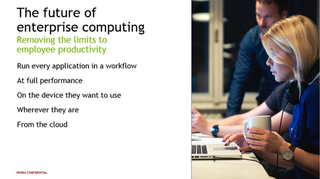
Nvidia announced that the second generation of its GRID platform, GRID 2.0, will be available worldwide this September, and the company promised big improvements over the first generation of the GRID GPU accelerated VDI platform. GRID 2.0 has been undergoing beta trials, with over a dozen fortune 500 companies in various industries, from aerospace to architecture, and Nvidia stated that the results have been tremendous.
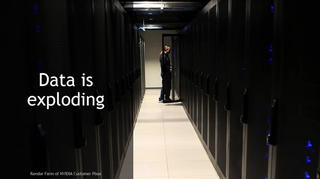
One of the biggest issues that large corporations face is how to manage the data that employees use every day. The old method has been to have a localized machine for every individual user, and then have a centralized server where the important documents are stored. This method worked well for many years, but these days, databases can be massive, and when you're working with visual data such as incredibly high-fidelity 3D renderings, the size of files can be detrimental to productivity. The problem is even more compounded when you're dealing with multiple satellite offices around the world.
Imagine an architecture firm with locations around the country with teams in all locations working together to build a hospital. In the old method, if someone at one site decided to change the layout of an area, the folks at all other locations wouldn't know until the data had replicated across the WAN. In many cases, this wouldn't happen until many hours later, and potentially not even until the next day. Now, think of the disaster if two people in each location unwittingly worked on the same section at the same time.
Pushing Pixels, Not Applications
A virtualized desktop platform completely mitigates that kind of a problem. All the data is hosted in one central location, and virtual desktops that are held in the same data center do all the processing work. None of the data leaves the data center at all, making it far less susceptible to breaches, and much quicker to work on. This is not to mention that any change made by one team member will be instantly seen by everyone else. It eliminates the need for replication, reducing hardware costs at satellite locations, as there is only ever one copy of a data set.
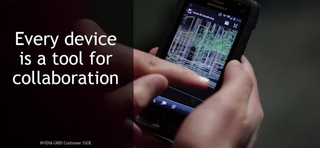
The other major benefit of virtualizing employee machines is that users can work from any device. IT departments will no longer need to worry about providing powerful desktop computers. Virtually any device can be a powerful desktop with VDI. A Chromebook, a tablet or a laptop share the same level of performance when connected to a virtual desktop.
VDI solutions have been around for many years, but historically to make them work, the visual quality of applications had to be lowered. This approach meant that the end user experience on a localized computer system was far superior to that of a virtual desktop. This made adoption impractical for many companies.
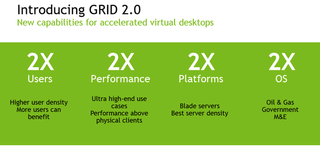
With the advent of GPU virtualization, Nvidia was able to increase performance of virtualized desktops to the point where applications could run with the same graphical properties as a locally installed counterpart. Nvidia said that with GRID 2.0, application performance is nearly doubled, making it possible to deliver more computing power than a high-end desktop PC to each user.
Stay on the Cutting Edge
Join the experts who read Tom's Hardware for the inside track on enthusiast PC tech news — and have for over 25 years. We'll send breaking news and in-depth reviews of CPUs, GPUs, AI, maker hardware and more straight to your inbox.
With GRID 2.0, Nvidia is offering models with 4 GB of frame buffer, as well as 8 GB options. The company stated that servers running 8 GB cards can exceed twice the performance per user over the previous generation, which was only available with 4 GB.

In addition to the performance per user, Nvidia GRID 2.0 doubles the user density per server. The updated platform has the ability to handle twice as many VMs. Nvidia tested Viewperf and ESRI ARcGIS Pro Draw Time on GRID 1.0 and GRID 2.0 and found the number of VMs before users complained about slowdown to be doubled in both cases. Having twice as many users per server means an organization can scale up faster, and more cost efficiently. GRID 2.0 is capable of running up to 32 VMs per GPU; GRID 1.0 topped out at 16 VMs.
Blade Server Support
One of the most demanded options for GRID was accessibility for Blade servers. Many large organizations have adopted this server form factor for their data centers because of the upgradeability and scalability, as well as the user density offered by Blade servers. The first generation of GRID was not available in such a small package. GRID 1.0 cards are designed for PCI-e slots and resemble the PC graphics card form factor. These cards were designed with dual GPUs, and Nvidia was not able to make the package small enough for Blades.
With GRID 2.0, cards are available in the same dual-GPU PCI-e configuration, but the company is also offering Blade-compatible single-GPU MXM modules for GRID 2.0. This is the same compact form factor that is found in modern gaming laptops with Maxwell GPUs installed. Hardware vendors are able to install a single MXM module into each single-width blade unit. The company said that double-width Blades are able to house up to four cards and stated that a Blade with this configuration would be able to manage 128 individual VMs.
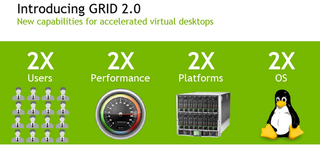
Linux On GRID
Another highly requested feature is the ability to run Linux on GRID. The oil and gas industries, as well as government and education institutions require Linux for certain applications. Nvidia found that in cases where Linux is required, organizations will not adopt a solution that doesn't work with Linux. For this reason, support for the open source OS was a priority of Nvidia. GRID 2.0 officially supports RedHat and Ubuntu, but the company said there should be no reason other distributions wouldn't work.
When queried about the latency drawbacks of having data centrally stored and accessed from abroad, Nvidia said that customer feedback suggested that the latency issues are far outweighed by the upsides of such an approach.
An example Nvidia offered is what Ford does with its design team. The company has product designers in America and in India. The team in India experiences approximately 200ms of latency, but without VDI, that group was limited to working on small components such as bolts and hinges. Seeing the whole 3D car model was impossible until virtual desktops were implemented, as the data set is far too large to transfer across the Internet. With the GRID VDI system, the design team in India is able to contribute to the entire project, not just small components.
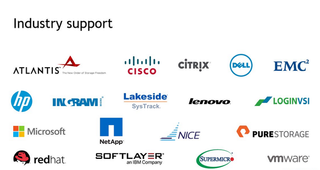
Nvidia GRID isn't just a piece of hardware that can be added to a server. GRID 2.0 is a specialized platform comprised of hardware and software. It is an ecosystem of partnerships between hardware vendors, management platforms and software companies. It's not possible to purchase an upgrade to GRID 2.0; all-new server hardware must be purchased.
Over 125 different server models have been validated to work with GRID 2.0 from Cisco, Dell, HP and Lenovo. VMWare has said vSphere 6 and Horizon 6 will work natively with GRID 2.0 without any updates needed, and Citrix XenApp and XenDesktop will support GRID 2.0, on both vSphere and XenServer.
Nvidia is running a demo of GRID 2.0 in action at VMworld this week. The company is set up at booth number 629. For those not in attendance, the company is also running the Nvidia GRID Test Drive with VMWare vSphere, which offers instant access to applications hosted through GRID 2.0 as a demonstration.
Nvidia GRID 2.0 will be available on September 15 through various partners and resellers. You can find more information, and sign up for a 90-day trial here.
Follow Kevin Carbotte @pumcypuhoy. Follow us @tomshardware, on Facebook and on Google+.
Kevin Carbotte is a contributing writer for Tom's Hardware who primarily covers VR and AR hardware. He has been writing for us for more than four years.
Most Popular

